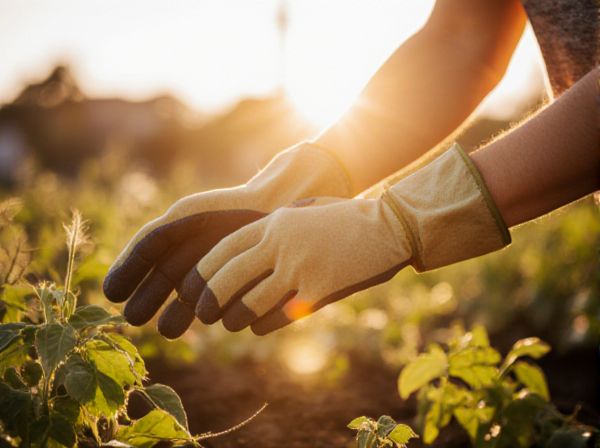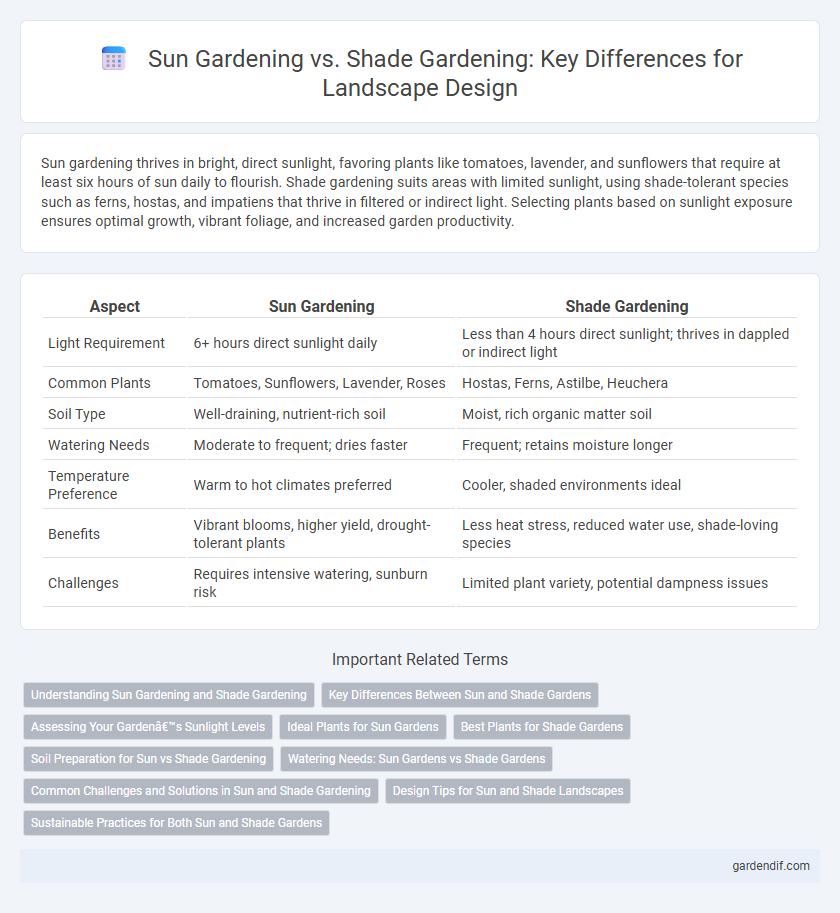
Sun Gardening vs Shade Gardening Illustration
Sun gardening thrives in bright, direct sunlight, favoring plants like tomatoes, lavender, and sunflowers that require at least six hours of sun daily to flourish. Shade gardening suits areas with limited sunlight, using shade-tolerant species such as ferns, hostas, and impatiens that thrive in filtered or indirect light. Selecting plants based on sunlight exposure ensures optimal growth, vibrant foliage, and increased garden productivity.
Table of Comparison
| Aspect | Sun Gardening | Shade Gardening |
|---|---|---|
| Light Requirement | 6+ hours direct sunlight daily | Less than 4 hours direct sunlight; thrives in dappled or indirect light |
| Common Plants | Tomatoes, Sunflowers, Lavender, Roses | Hostas, Ferns, Astilbe, Heuchera |
| Soil Type | Well-draining, nutrient-rich soil | Moist, rich organic matter soil |
| Watering Needs | Moderate to frequent; dries faster | Frequent; retains moisture longer |
| Temperature Preference | Warm to hot climates preferred | Cooler, shaded environments ideal |
| Benefits | Vibrant blooms, higher yield, drought-tolerant plants | Less heat stress, reduced water use, shade-loving species |
| Challenges | Requires intensive watering, sunburn risk | Limited plant variety, potential dampness issues |
Understanding Sun Gardening and Shade Gardening
Sun gardening thrives in areas receiving at least six hours of direct sunlight daily, favoring heat-tolerant plants like tomatoes, marigolds, and lavender. Shade gardening suits locations with limited sunlight, typically under tree canopies or north-facing walls, supporting shade-loving plants such as hostas, ferns, and impatiens. Understanding the light requirements and optimal plant selections for each gardening style ensures healthier growth and vibrant landscapes.
Key Differences Between Sun and Shade Gardens
Sun gardening requires plants that thrive in full sunlight, typically needing at least 6 hours of direct sun daily, while shade gardening favors species adapted to low light conditions, often under tree canopies or structures blocking sunlight. Soil moisture and temperature also differ; sun gardens tend to dry out faster and heat up more, necessitating drought-tolerant plants, whereas shade gardens retain moisture longer and stay cooler, supporting moisture-loving, shade-tolerant varieties. Plant selection, watering frequency, and garden placement are crucial factors that distinguish sun gardening from shade gardening practices.
Assessing Your Garden’s Sunlight Levels
Assessing your garden's sunlight levels is essential for successful sun gardening or shade gardening, as each requires distinct light conditions for optimal plant growth. Use a light meter or observe the garden at different times of day to determine sunlight intensity and duration, categorizing areas into full sun (6+ hours), partial sun/shade (3-6 hours), or full shade (less than 3 hours). Understanding these sunlight levels helps select appropriate plant species--for example, sun-loving roses thrive in full sun, while shade-tolerant ferns prosper in low-light zones--ensuring healthy, vibrant landscapes.
Ideal Plants for Sun Gardens
Ideal plants for sun gardens include drought-tolerant species such as lavender, coneflowers, and sedum, which thrive in full sunlight and require minimal water. Sun-loving perennials like black-eyed Susan, Russian sage, and yarrow provide vibrant colors and attract pollinators while enduring high temperatures. Incorporating ornamental grasses such as blue fescue and fountain grass adds texture and resilience to sunny landscapes.
Best Plants for Shade Gardens
Hostas, ferns, and astilbes thrive in shade gardens, providing lush foliage and vibrant blooms despite limited sunlight. These plants are adapted to low-light conditions and contribute to a thriving, visually appealing landscape under tree canopies or shaded areas. Selecting shade-tolerant species improves garden health and ensures continuous growth throughout the seasons.
Soil Preparation for Sun vs Shade Gardening
Soil preparation for sun gardening requires well-draining soil enriched with organic matter to retain moisture and support heat-tolerant plants. In shade gardening, soil tends to be cooler and moister, often needing increased aeration and added compost to improve nutrient availability for shade-loving plants. Adjusting soil pH and texture according to sunlight exposure enhances root development and overall plant health in both sun and shade gardens.
Watering Needs: Sun Gardens vs Shade Gardens
Sun gardens generally require more frequent watering due to increased evaporation rates and higher temperatures that dry out the soil quickly. Shade gardens retain moisture longer because reduced sunlight decreases evaporation, allowing for less frequent watering schedules. Efficient irrigation strategies, such as drip systems, are recommended for sun gardens to maintain consistent soil moisture and reduce water waste.
Common Challenges and Solutions in Sun and Shade Gardening
Sun gardening often faces challenges such as soil drying out quickly and increased risk of plant stress due to intense sunlight, while shade gardening struggles with limited photosynthesis and slower plant growth. Solutions include selecting drought-tolerant species like lavender and succulents for sun gardens, and shade-loving plants such as hostas and ferns for shaded areas. Implementing strategic watering schedules and using mulch can help retain moisture in both sun and shade gardens, improving overall plant health and resilience.
Design Tips for Sun and Shade Landscapes
Sun gardening thrives with drought-tolerant plants like lavender, sedum, and ornamental grasses that require full sunlight for optimal growth, enhancing vibrant color and texture in the landscape design. Shade gardening favors plants such as hostas, ferns, and astilbes that flourish in low-light conditions, providing lush greenery and structural contrast to shaded areas. Combining elements like garden beds, pathways, and accent lighting strategically maximizes the visual appeal and functional use of both sun and shade zones.
Sustainable Practices for Both Sun and Shade Gardens
Sustainable sun gardening emphasizes drought-tolerant plants like lavender and succulents that reduce water usage and require minimal maintenance, while shade gardening relies on native ferns and hostas that thrive in low light and enhance soil health through deep root systems. Organic mulching and composting are essential for both garden types, improving soil structure and retaining moisture without chemical inputs. Implementing rainwater harvesting and integrated pest management further supports eco-friendly growth in diverse light conditions.
Sun Gardening vs Shade Gardening Infographic

 gardendif.com
gardendif.com